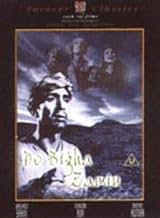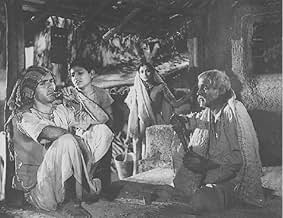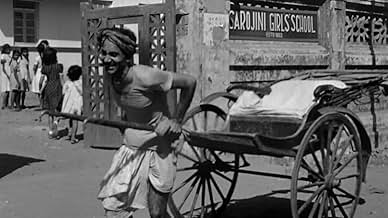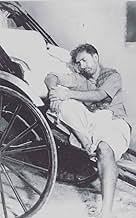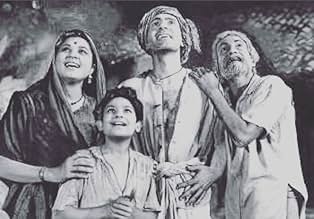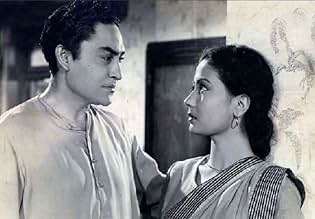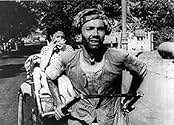NOTE IMDb
8,3/10
2,4 k
MA NOTE
Ajouter une intrigue dans votre langueIn the hope of earning enough money to pay off his debts and save his land, a poor farmer becomes a rickshaw puller in Calcutta and faces many difficulties.In the hope of earning enough money to pay off his debts and save his land, a poor farmer becomes a rickshaw puller in Calcutta and faces many difficulties.In the hope of earning enough money to pay off his debts and save his land, a poor farmer becomes a rickshaw puller in Calcutta and faces many difficulties.
- Réalisation
- Scénario
- Casting principal
- Récompenses
- 4 victoires et 2 nominations au total
Ratan Kumar
- Kanhaiya Maheto
- (as Rattan Kumar)
Rajlakshmi Devi
- Nayabji
- (as Rajlakshmi)
Nasir Hussain
- Rickshaw puller
- (as Nazir Hussain)
Ramayan Tiwari
- Paro's molester
- (as Tiwari)
Avis à la une
This movie is a must see. It shows poverty with a humanistic approach in 1953 India. I went to Calcutta in 1999 and people still ride on human rickshaws (a person runs barefoot on streets while pulling the rickshaws for few cents). It is a very sad. It is heart breaking. In this movie get to see a common man problems and how he or she deals with it. It shows how corrupted the rich are and using the poor for their own means. This is how a 1/3 of India lives in today hi tech India. This is how people are suffering with all the economic boom India has. This is how people live in today's Independent and Free India. This movie is a must see.
Do Bigha Zamin is one of the pioneering films of 1950's starting the trend of parallel cinema. Bimal Roy like his other contemporary Bengali director in golden period of Indian film industry took an important social problem an converted into a 142min of struggle,misery and poverty. Protagonist Shambu (Balraj Sahni) is forced to sell his land 2 Bigha(unit) by Zameedar who wants to build a factory by demanding debt once given on interest.court ordered Shambu to pay in 3 months for which Shambu goes to Calcutta-the cruel city.city takes test of Shambu and his son Kanhaiya(Ratan Kumar) to save each penny. Balraj as usual looked perfect in his character of Shambu Mahto but for me real surprise was child artist Ratan Kumar who outplayed every other actor. Salil Chaudhary used music very smartly to not make film dramatic and keep it as real as possible.Bimal Roy was inspired from Vittorio De Sica's bicycle thieves which is landmark film in world cinema .2 Bigha Zameen was praised by critics internationally and won first Filmfar and international prize in Cannes. Bimal Roy's magic took our Shambu to the heart of west and still maintained Indian.
Of course it is true that Do Bigha Zamin is strongly influenced by Vittorio de Sica's neorealist classic Bicycle Thieves (very improperly retitled Bicycle Thief in the English version). But De Sica's film has influenced virtually every realist film (and many non-realist films) ever since the day it first appeared. It is a crucial reference in world cinema and will probably always remain one.
It was of course particularly influential on all the Indian neo-realists of the fifties, including the greatest of them all - Satyajit Ray. Roy, like Ray a Bengali, would have imbibed that influence before ever he abandoned New Theatres in Calcutta to come to Bombay. He is not an especially innovative director. Devdas (1955) for instance is essentially a Hindi remake of a thirties classic of Bengali cinema; other Roy films show an eclectic range of influences. So it is not surprising to find him in Do Bigha Zamin attempting to adapt the style (and to some extent) the structure of Bicycle Thieves to an Indian context.
Once one has admitted that, however, it should not I think be seen as some sort of shameful plagiarism and one can go on to appreciate some of the real plusses of Roy's film. It is true that it is less restrained than the Italian model; Roy piles on the agony in no uncertain terms and tends to oversentimentalize. Note however that he resists any facile optimism...
The adaptation to a rural Indian context alters the politics of the film, concentrating on the issue (a burning issue to this day in rural India) of the cycle of debt and exploitation to which small peasant farmers in India are subjected (a theme that Mehboob Kahn had already explored in his film Aurat and would do again most famously in Mother India in 1957). This is a less subtle theme perhaps than that of De Sica (where in an urban context it is the poor who steal from the poor and prolong the cycle of misery) but it is nonetheless an important one and Roy (and Balraj Sahni who is excellent) paints a convincing picture of village-life and rural values.
Roy very deliberately counterbalances the picture of misery (rural and urban) with examples of solidarity, of the poor helping the poor, whether on the level of the adults or of the street-boys. And perhaps the most touching and most natural part of Roy's film - and something that owes nothing to De Sica - is his portrayal of the street-kids of Calcutta (which very interestingly prefigures Mira Nair's much later Salaam Bombay). Instead of being isolated companions as in the De Sica film, the father and son in Roy's film experience two rather different aspects of urban life and this layering of the story is perhaps Roy's most significant achievement.
Can one put paid once and for all, finally, to this idea that a realistic film or a film showing social awareness is uncharacteristic of Indian cinema (based on an essentially modern image of "Bollywood")? The golden age of Indian cinema (say 1949 to 1964) abounds in realistic films and films which, while not necessarily realistic in a strict sense of the term, show a good deal of social awareness. It is the period that includes the most memorable films of Satyajit Ray, Rithwik Gathak and Tapan Sinha, the films of Guru Dutt, the early films of Raj Kapoor, those of Bimal Roy, Mehboob Kahn's Mother India but also amongst relatively minor films, Arora's Boot Polish and B R Chopra's Naya Daur. To say nothing of great films in a non-realistic genre such as Mughal-e-Azam (1960) and Pakeezah (largely filmed during the period although not completed until 1972). By comparison with any contemporary cinema anywhere in the world including certainly American cinema, including even that of Japan (also experiencing something of a golden age at that time), it is a very impressive record.
Roy may not be amongst the first rank of cinematic geniuses - I would not put him in the same class as Ray or Gathak or for that matter as Guru Dutt, in my view the finest of the Hindi film directors of the period. He was a populariser (quite determinedly so) and constituted as such an important bridge between the more 'arty' Bengali and more 'popular' Hindi film industries of the time. His contribution remains an important and enduring one to an Indian cinema (and a popular Indian cinema) of real quality that has nothing to do with "Bollywood"...
It was of course particularly influential on all the Indian neo-realists of the fifties, including the greatest of them all - Satyajit Ray. Roy, like Ray a Bengali, would have imbibed that influence before ever he abandoned New Theatres in Calcutta to come to Bombay. He is not an especially innovative director. Devdas (1955) for instance is essentially a Hindi remake of a thirties classic of Bengali cinema; other Roy films show an eclectic range of influences. So it is not surprising to find him in Do Bigha Zamin attempting to adapt the style (and to some extent) the structure of Bicycle Thieves to an Indian context.
Once one has admitted that, however, it should not I think be seen as some sort of shameful plagiarism and one can go on to appreciate some of the real plusses of Roy's film. It is true that it is less restrained than the Italian model; Roy piles on the agony in no uncertain terms and tends to oversentimentalize. Note however that he resists any facile optimism...
The adaptation to a rural Indian context alters the politics of the film, concentrating on the issue (a burning issue to this day in rural India) of the cycle of debt and exploitation to which small peasant farmers in India are subjected (a theme that Mehboob Kahn had already explored in his film Aurat and would do again most famously in Mother India in 1957). This is a less subtle theme perhaps than that of De Sica (where in an urban context it is the poor who steal from the poor and prolong the cycle of misery) but it is nonetheless an important one and Roy (and Balraj Sahni who is excellent) paints a convincing picture of village-life and rural values.
Roy very deliberately counterbalances the picture of misery (rural and urban) with examples of solidarity, of the poor helping the poor, whether on the level of the adults or of the street-boys. And perhaps the most touching and most natural part of Roy's film - and something that owes nothing to De Sica - is his portrayal of the street-kids of Calcutta (which very interestingly prefigures Mira Nair's much later Salaam Bombay). Instead of being isolated companions as in the De Sica film, the father and son in Roy's film experience two rather different aspects of urban life and this layering of the story is perhaps Roy's most significant achievement.
Can one put paid once and for all, finally, to this idea that a realistic film or a film showing social awareness is uncharacteristic of Indian cinema (based on an essentially modern image of "Bollywood")? The golden age of Indian cinema (say 1949 to 1964) abounds in realistic films and films which, while not necessarily realistic in a strict sense of the term, show a good deal of social awareness. It is the period that includes the most memorable films of Satyajit Ray, Rithwik Gathak and Tapan Sinha, the films of Guru Dutt, the early films of Raj Kapoor, those of Bimal Roy, Mehboob Kahn's Mother India but also amongst relatively minor films, Arora's Boot Polish and B R Chopra's Naya Daur. To say nothing of great films in a non-realistic genre such as Mughal-e-Azam (1960) and Pakeezah (largely filmed during the period although not completed until 1972). By comparison with any contemporary cinema anywhere in the world including certainly American cinema, including even that of Japan (also experiencing something of a golden age at that time), it is a very impressive record.
Roy may not be amongst the first rank of cinematic geniuses - I would not put him in the same class as Ray or Gathak or for that matter as Guru Dutt, in my view the finest of the Hindi film directors of the period. He was a populariser (quite determinedly so) and constituted as such an important bridge between the more 'arty' Bengali and more 'popular' Hindi film industries of the time. His contribution remains an important and enduring one to an Indian cinema (and a popular Indian cinema) of real quality that has nothing to do with "Bollywood"...
Bicycle Thieves is a very touching Italian movie. But this one is our own native version of that. With genuine plot and out-of-the-world cinematography, Do Bigha Zamin is Indian masterpiece.
The actors are terrific, totally portraying the characters given to them. Music, direction, screenplay & the execution is all marvelous. Even today, this works because it talks about poverty, life, emotions, relationships & virtues. Fantastic. Moreover, the intricacy with which details are kept in focus should be the USP of this film. 9.1/10.
BOTTOM LINE: Get that DVD right now. A must-watch.
Can be watched with a typical Indian family? YES
Profanity: No | Sex/Nudity: No | Violence: Very Mild | Gore: No | Alcohol/Smoking: No | Drugs: Mild (Hookah)
The actors are terrific, totally portraying the characters given to them. Music, direction, screenplay & the execution is all marvelous. Even today, this works because it talks about poverty, life, emotions, relationships & virtues. Fantastic. Moreover, the intricacy with which details are kept in focus should be the USP of this film. 9.1/10.
BOTTOM LINE: Get that DVD right now. A must-watch.
Can be watched with a typical Indian family? YES
Profanity: No | Sex/Nudity: No | Violence: Very Mild | Gore: No | Alcohol/Smoking: No | Drugs: Mild (Hookah)
This movie is a an Indian classic.... I don't know why so many people here are going on about how unrealistic it is...... I would wonder how many who commented as such have actually been to that part of India and witnessed the poverty there....
The story may well have been copied but the film is no doubt still great. I cant think of many other copies which are actually good. This film does actually touch you with its sadness, and claims of melodramaticness will be gladly tossed aside because we are talking about Indian cinema here...
All in all i think this is definitely a gem in Indian cinema, and fit the bill of an all time classic.
The story may well have been copied but the film is no doubt still great. I cant think of many other copies which are actually good. This film does actually touch you with its sadness, and claims of melodramaticness will be gladly tossed aside because we are talking about Indian cinema here...
All in all i think this is definitely a gem in Indian cinema, and fit the bill of an all time classic.
Le saviez-vous
- AnecdotesWhen the shoeshine boys discuss seeing Nargis in Le vagabond (1951), one of them alludes to a shirt worn by a bystander. The shirt is decorated with a recurring pattern showing the famous scene from Le vagabond (1951) in which Raj Kapoor comes upon Nargis as she is changing clothes, partially hidden by a screen, after swimming. That scene occupies a place in Hindi cinema comparable to that of Deborah Kerr and Burt Lancaster on the beach in Tant qu'il y aura des hommes (1953).
- ConnexionsFeatured in Century of Cinema: 100 ans de cinéma: 100 ans de cinéma indien (1996)
- Bandes originaleshariyaala saawan dhol bajaata aaya
Sung by Lata Mangeshkar, Manna Dey
Meilleurs choix
Connectez-vous pour évaluer et suivre la liste de favoris afin de recevoir des recommandations personnalisées
2025 Venice Film Festival Guide
2025 Venice Film Festival Guide
See the full lineup for the 2025 Venice Film Festival, taking place Aug. 27 – Sept. 9, 2025.
- How long is Do Bigha Zamin?Alimenté par Alexa
Détails
- Durée
- 2h 11min(131 min)
- Couleur
- Rapport de forme
- 1.37 : 1
Contribuer à cette page
Suggérer une modification ou ajouter du contenu manquant


